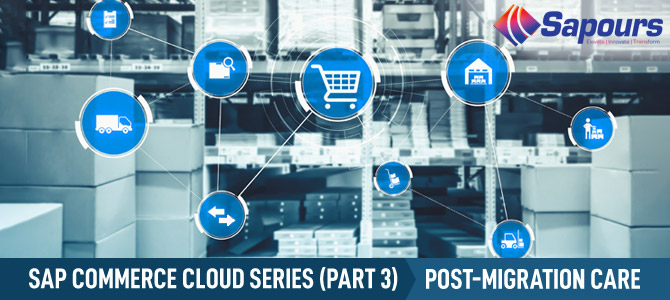As new versions of SAP Commerce constantly get released, upgrading/migrating to the latest version is critical to take full advantage of all the new features, bug fixes, and improvements. However, successful migration doesn’t end at just deploying the latest release. You also need to be able to use the solution to the fullest and leverage all the modern features that SAP has to offer, to drive the best business results as well as maximize your returns from the investment you’ve made.
In the third part of our 4-part blog series on SAP Commerce Cloud Migration, we are throwing light on how you can make the best use of all the capabilities of the latest version.
Here are the links to the other blogs in the series
SAP Commerce Cloud Series (Part 1) – Upgrade and Migrate – The Need of the Hour
Making the most of the migration
SAP Commerce Cloud is a well-established and popular commerce solution for large enterprises with advanced B2B, B2C, and B2B2C use cases. It helps in creating exceptional omnichannel experiences while allowing organizations to meet their digital commerce needs across the most complex catalogs, products, and configurations. With powerful and comprehensive commerce capabilities, the platform aids in capitalizing on emerging revenue opportunities and unlocks enterprise-wide intelligence to drive profitable growth.
Upgrading your SAP Commerce platform to the latest cloud version can open doors to new and improved functionality, allowing you to transform your business operations. By getting access to important performance improvements, updated bug and security fixes, and new and enhanced features, you can get rid of legacy code, integrate more easily with other systems, and deliver innovation to your customers.
But just running on the latest and fully-supported version of SAP Commerce is not enough; to ensure all the time, money, and effort you’ve put into migration pays off, there are some tips to keep in mind:
- Thoroughly test the system: One of the first steps to take while you migrate your SAP Commerce Platform migration to the cloud is to thoroughly test the solution thoroughly before it’s deployed into production. Such detailed testing will not only assess if the system is working as intended; it will also give you full confidence across all aspects of the platform. Running an array of regressing, database, media migration, integration, acceptance, security, and performance tests is highly recommended to reduce the risk of unknown issues and to increase the quality of the migration.
- Assess the newly migrated system: Despite ticking all the migration checkboxes, there is still a likelihood that the new system is not performing per expectations. To check if you’ve done the migration properly, used the right methods and tools for migration, and evaluated if all integrations are mapped properly, you need to assess and monitor the newly migrated system and identify if any issues are hampering user experience. These can range from slow integrations to features not working as expected and more.
- Check for infrastructure issues: When you migrate your SAP Commerce platform to the cloud, you need to check if there are any issues with the newly-migrated infrastructure. Verify customizations, determine if third-party CDNs and WAFs are working properly, evaluate the functioning of VPN connections with existing on-prem servers, and confirm if all the modules you require are performing as expected.
- Train and educate users on all the latest capabilities: To ensure business users are aware of the different changes in the latest version of SAP Commerce, you need to constantly train and educate them. Enrolling users in classroom-based and virtual training sessions will allow them to learn about the latest features, concepts, and user interface improvements from a functional perspective while also getting an all-around view of the software. Right from information on all the modules to web content management features, search enhancements, order and payment improvements, security updates, and more.
- Ensure you are leveraging innovations to the fullest: The latest version of SAP Commerce offers an array of new and improved features, but most business users are unaware of this exhaustive list. To ensure every user is leveraging all the new innovations to the fullest, it is important to make them aware of the different capabilities they can leverage to better do their jobs, better collaborate with peers, and better meet customer expectations.
- Leverage automated updates and patches: Since the SAP Commerce platform lives in the cloud, automated updates and patches are part of the game. SAP continues to develop the platform on a continuous basis. Therefore, you can be sure to get new enhancements with each update. While most of these updates are delivered automatically, make sure to keep an eye on those that involve configuration, so you can drive greater value and benefits from your platform.
Partner with Sapours!
Whether you’ve taken the lift-and-shift approach to migrate your SAP Commerce project to the cloud or extensively rearchitected your existing system, the upgraded version of this scalable cloud platform will empower you with all the capabilities you need to go to market quickly and drive endless innovation and growth.
If you want to achieve success with your SAP Commerce migration, partnering with an organization like Sapours can help you reinvent, simplify, and strengthen your eCommerce business while also allowing you to drive the agility and intelligence needed in today’s world of digital commerce.
Our skilled and proficient consultants have strong SAP Commerce domain expertise and have delivered commerce strategy and roadmap assessment, impact analysis, and high-powered UI/UX capabilities for high-performance eCommerce B2B and B2C sites. You can leverage our Quick Deployment Framework and custom SAP Commerce accelerators to enjoy faster time-to-value for your migration and quickly adapt and scale your SAP platform as your digital business grows.
Having us take care of the day-to-day monitoring and maintenance of your newly-migrated SAP platform means your customers can enjoy a unified customer experience across multiple touchpoints and make the most of a highly personalized shopping experience.

